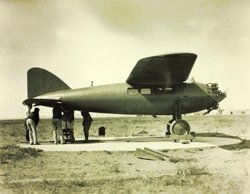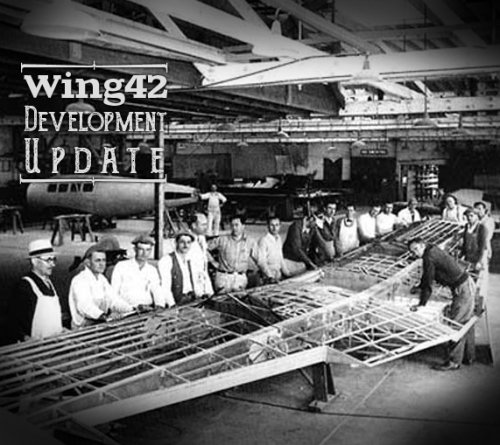The Lockheed Vega for Flight Simulator has been in development for almost a year now. And since this is the first time I am writing about it, I don’t really know how to start. There are so many things that make this project exciting for me, so many details that we try to incorporate into our simulation and a lot of interesting things that we accomplished so far. I will try to keep my development logs concise and limited to a selected topic to make them a more interesting read.
Rather than writing about our project, I want to use the first devblog to outline the history and significance of the Lockheed Vega.

The Vega was developed in 1927, the dawn of the Golden Age of aviation. It was originally developed as a commercial passenger aircraft, but became much more successful as an executive plane. It played a significant role in pushing the envelope of aviation – due to it’s innovative design it was chosen by pioneers like Amelia Earhart and Wiley Post to set new world records in altitude, endurance and speed. These records were made possible due to the extraordinary design and production process that Jack Northrop (who later founded Northrop Corporation) and Allan Loughead (founder of the Lockheed Aircraft Manufacturing Company) came up with. Most aircraft of that era were made using a plywood framework covered in canvas. While the Vega too used plywood, it actually featured a monocoque design, meaning that the outer skin of the fuselage gave the aircraft a big chunk of the structural integrity. This was achieved by forming the fuselage in a specially produced mold in which the workers lay out multiple layers of wooden shavings (veneer strips) and bind them with glue. Using this elaborate process made it possible to save weight on a rigid support framework for the fuselage, making the aircraft lighter than comparable types.

The designers also took great care in streamlining everything on the ship, including the wheel fairings, making the Vega extremely fast for it’s time. Lockheed was also quick to adopt the NACA cowling when it was proposed by the National Advisory Committee for Aeronautics (the predecessor to NASA), thus further improving the aerodynamics of the airplane. This was not the only thing that changed between the early version and the later ones. The tail section of the aircraft improved over time as well, giving the vertical stabilizer and rudder more surface area for enhanced control. Lockheed also offered more and more powerful engines with each redesign to allow for better performance and a higher gross weight. While the first Vegas could only accommodate four passengers and the pilot, later versions transported up to six passengers.
Amelia Earhart’s Vega(s)

The Lockheed Vega was famously flown by aviatrix Amelia Earhart to solo across the Atlantic ocean in 1932. She subsequently took other record-breaking flights in the Vega. She sold her Vega 5B in favor of the upgraded Vega 5C in 1934. Her old Vega 5B is now on display at the Smithsonian National Air and Space Museum in Washington. Earhart was the first woman to solo the USA coast-to-coast in the newly purchased Vega 5C and she was first pilot to solo from Honolulu, Hawaii to mainland USA. She later transitioned to the Lockheed Electra 10E to undertake her tragic, failed attempt of circumnavigating the earth with her navigator Fred Noonan.
Wiley Post’s Vega(s)

You can’t talk about the Lockheed Vega without mentioning one-eyed pilot Wiley Post and the Winnie Mae. Shortly after taking up flying Wiley Post lost his left eye while he was working for an oil company (to finance his flying). But Post was determined and kept flying anyway. With only one functioning eye, his spacial perception was out the window. But he trained himself to guess distances or heights based on surrounding cues. For instance, he’d judge the height of objects on the ground to relate it to the height of his airplane. He trained hard and managed to keep his pilot’s license.
Wiley Post started out flying the Lockheed Vega 5 “Winnie Mae” for the oilman F.C. Hall. In 1930 he won the National Air Race Derby by flying the distance between Los Angeles to Chicago in 9 h 9 min. In 1931 he and his navigator Harold Gatty circumnavigated the globe in a record-breaking 8 days, 15 hours and 51 minutes, making them national heroes. He bought the “Winnie Mae” from Hall and prepared for the next huge milestone of flying a similar route around the world, but this time solo. He achieved his goal in 1933 beating his own record by another day. Only a year later, Wiley Post made headlines again flying the Lockheed Vega to the breath-taking altitude of 50,000 feet ASL. He achieved this utilizing a supercharged engine and a pressure suit, allowing him to breath normally (more or less).
Wiley Post crashed fatally shortly after takeoff from a lake near Fairbanks in Alaska on an attempt to establish a new mail route between the West coast of the USA and Russia. For this endeavor he merged the fuselage of a Lockheed Orion with the wide wings of a Lockheed Explorer. The float-plane was very nose-heavy at slow speeds and Wiley Post lost control of the aircraft after an engine failure shortly after takeoff.
Conclusion
The Lockheed Vega was a remarkable aircraft for it’s time. It was versatile, fast and reliable. It embraced modern technology, pushed the envelope and helped shape the future of aviation. Wing42 is working tirelessly to bring the Lockheed Vega 5 to your flight simulator!




 Microsoft Flight Simulator Add-ons
Microsoft Flight Simulator Add-ons Flight Simulator X Add-ons
Flight Simulator X Add-ons